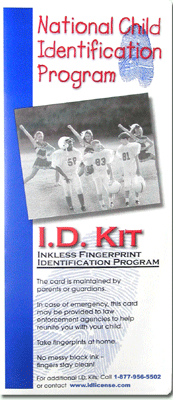
The National Child Identification Program inkless fingerprint I.D. Kit allows parents to take and store their child's Parents do not need to be fingerprint experts - a black fingerprint appears immediately on the identification card when the clear inkless solution makes contact with the coated fingerprint section of the card. Each Identification kit is comprised of (1) an inkless fingerprinting card, (2) a DNA collection envelope, and (3) a laminated wallet card. |
1.
Inkless Fingerprinting Card
- Step-by-step
instructions detailing how to take a fingerprint
- An
area to practice fingerprinting
-
A standard fingerprint area that can be used by law enforcement
- Foil
pouch containing inkless fingerprinting solution
- Sections
for recording the child’s physical description and
identifying marks
- Sections
for recording a doctor's phone numbers
- Space for a Current photograph
2. The DNA Collection Envelope
- Contains two sterile swabs for obtaining DNA from the inside of child's check
3.
Laminated Wallet Card
- Carry
your child’s basic information with you while away
from home
- A
location for a brief description of the child
- Contains
a picture of the child
- Contains a thumb print of the child (inkless fingerprint)
The
entire fingerprinting process lasts approximately five minutes.
If ever needed, the completed identification card can immediately
give authorities the vital information they need to assist them in their efforts to locate a missing child.
The National Child Identification Program is more effective
than traditional identification programs because it offers:
-
Comprehensive, descriptive information in one place:
Children's appearances change rapidly, and simple alterations in clothes or hair make identification difficult. The ID Kit includes a section for a current photograph, as well as space for recording descriptions and measurements.
-
Decentralized fingerprinting:
There are not enough police officers or labor available to centrally fingerprint America's children using traditional methods. It would take more than 10 million hours or 4,800 working years, to centrally fingerprint the nation's 60 million children.
Inkless fingerprinting process:
U.S. Patent No. 6,030,655
HOW FINGERPRINTS CAN HELP FIND A MISSING CHILD ?
If a child is missing, law enforcement authorities can use the child's completed I.D. Kit to scan the child's fingerprints into the National Crime Information Center database. These fingerprints can then be used to help locate the child in a variety of ways. For example:
- John, age 12, is abducted by his father, who is divorcing his mother and believes the court will not grant him visitation. John's father takes him from Boston to Los Angeles. For the next four years, John and his father have absolutely no contact with John's mother. When John turns 16, he goes to the Department of Motor Vehicles to get his driver's license. The DMV scans his fingerprint, which is entered into the DMV's database. From there, it is automatically sent to the California Crime Information Center and the National Crime Information Center. The fingerprint matches the record of a missing child in Boston, and John is reunited with his mother.
- Sarah, age 14, runs away from her home in Dallas. She has been gone for six months and is forced to turn to shoplifting to continue her flight. Her crimes are not large - a loaf of bread here, a carton of milk there - but eventually she is caught and fingerprinted in Tucson, Ariz. When her fingerprints are sent to the National Crime Information Center, they show that Sarah is a runaway from Dallas. The police are notified, and Sarah is reunited with her parents.
Thirty years ago, this type of recovery scenario would not have been possible. However, advances in technology, increased education, continued collaboration between law enforcement agencies, and an ever-growing number of parents fingerprinting their children are helping to make a very real impact on law enforcement's ability to locate a missing child.
FACTS ABOUT FINGERPRINTS
Fingerprints are composed of a unique combination of ridges that make patterns of loops, deltas and arches, as well as ending ridges, broken ridges, island ridges, forks, dots, bridges, spurs, eyes, bifurcations and other distinguishing marks. Fingerprinting is the only notably unchanged and infallible means of identifying individuals. In 80 years of fingerprint classification, no two identical sets have been found.
Unique fingerprints are formed seven months after conception. Although the size of each finger will continue to grow from pre-birth to childhood to adulthood, the relative position of ridges (with their loops, deltas and arches) will remain the same.
A perfect fingerprint will yield 175 to 180 points of information. Twelve points (less than 10 percent of a fingerprint) are required to convict in a federal court, and as few as five points may be used to convict in many jurisdictions. In other words, a far-from-perfect print will still yield positive identification information.
 fingerprints in their own home.
fingerprints in their own home. 
